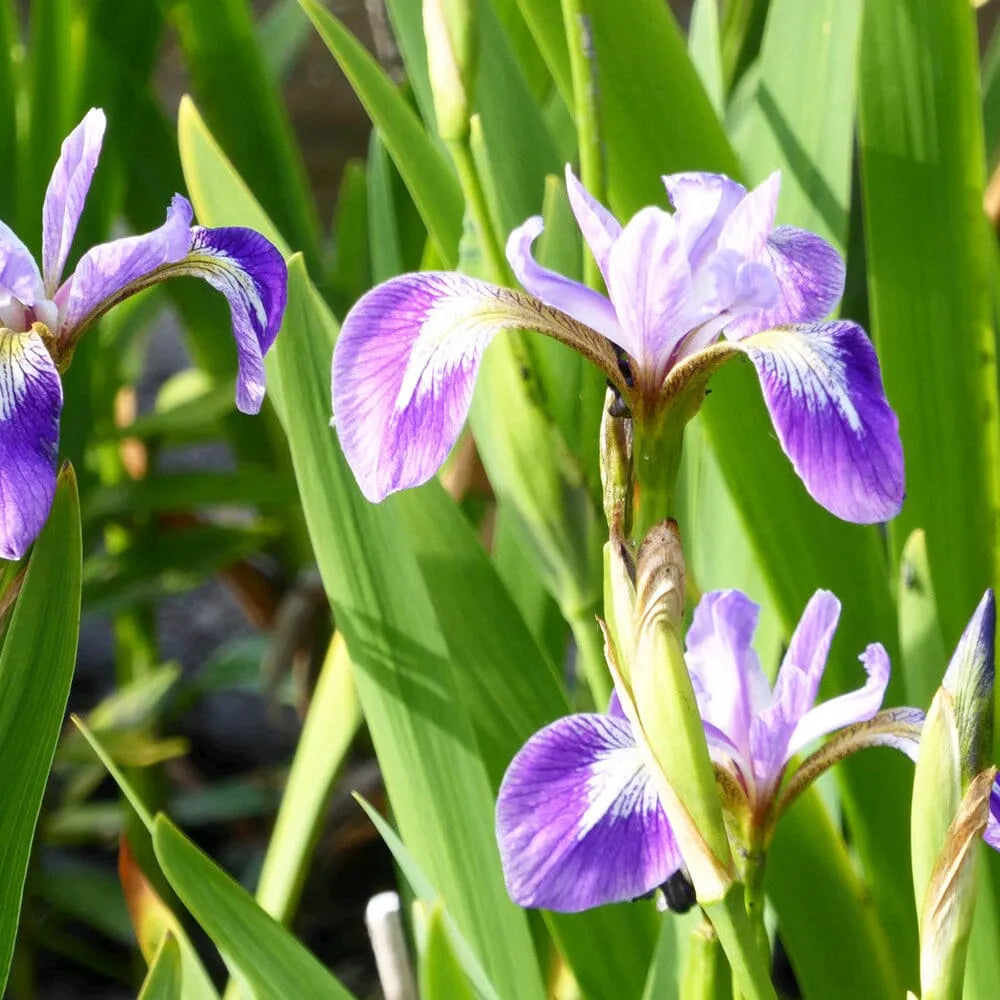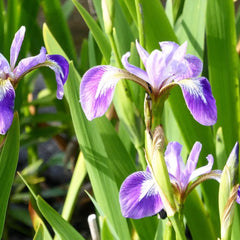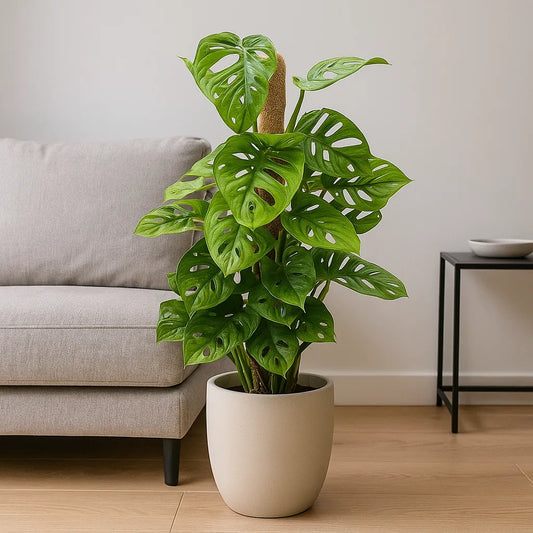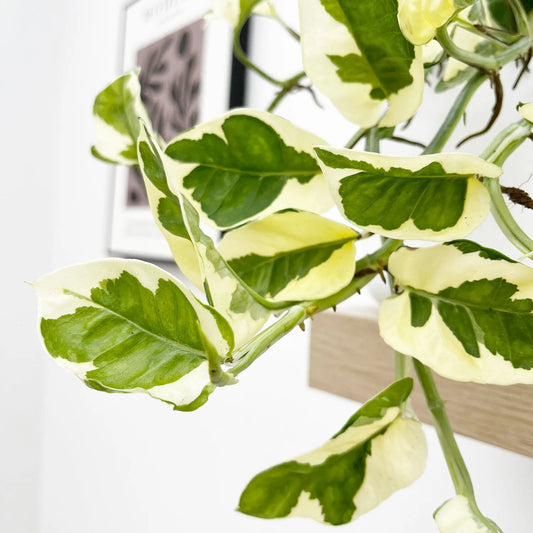

Iris Versicolor Aquatic Pond Plant - Blue Flag Iris
- £17.99
- £17.99
- Unit price
- per
Live Delivery Guarantee
At Plants for all Seasons, we stand behind the quality and vitality of every plant we deliver, which is why we proudly offer a Live Delivery Guarantee. This commitment means that we guarantee your plants will arrive at your doorstep in healthy, thriving condition. We understand the importance of receiving your plants in the best possible state, ready to enhance your space from the moment they arrive. With Plants for all Seasons's Live Delivery Guarantee, you can shop with complete peace of mind, knowing that your green investments are protected from our nursery to your doorstep.
30 Days Returns
Due to the sensitive and breakable nature of our products, it's understandable that damages may occur despite our meticulous packaging methods. If you find that your plant or pot has arrived in a less than satisfactory condition, please reach out to us at hello@plantsforallseasons.co.uk within a month of your delivery date. When contacting us, please provide your order reference, alongside a photo clearly showing the damaged item and its packaging, including the delivery label. We are committed to resolving such issues by offering a refund or a replacement, depending on the availability of the item in question.
We are unable to accept returns that are not related to damage because plants are inherently perishable and delicate. It's also worth noting that the plant you receive may slightly differ from the images displayed on our website. This variation is natural, given that each plant is unique and subject to seasonal growth changes.
Safe and Secure Delivery
At Plants for all Seasons, we recognise the critical role our courier partners play in ensuring the safe and secure delivery of your plants. We collaborate exclusively with leading courier services, renowned for their reliability and exceptional handling practices, to ensure your plants arrive in perfect condition. Our partners are carefully selected based on their commitment to timely deliveries and their proven track record in transporting delicate items with the utmost care.
Bespoke Eco Packaging
At Plants for all Seasons, our commitment to the environment extends to every aspect of our operations, especially in how we deliver your plants. We take pride in our bespoke, eco-friendly packaging, meticulously designed for the safe transport of live plants. Our innovative packaging solutions are crafted from sustainable materials, ensuring that your plants are not only secure but also that their journey from our nursery to your home treads lightly on the earth. This thoughtful approach minimises stress on the plants and reduces waste, aligning with our mission to promote a greener, more sustainable future.
Free Delivery Over £100
At Plants for all Seasons, we're delighted to offer our customers an exclusive perk: free delivery on all orders over £100. No matter how many plants you fall in love with, if your total reaches £100, the delivery is on us. This offer is our way of saying thank you for choosing us for your greenery needs and to make it easier for you to welcome more of nature’s beauty into your home without worrying about additional costs. Our commitment to providing value doesn't stop at our plant selection; it extends to ensuring that your chosen foliage arrives at your doorstep with care and precision, completely free of charge for qualifying orders. Enjoy the convenience of selecting from our wide range of plants, safe in the knowledge that your delivery costs are covered when you meet the threshold. It’s our way of helping you create your ideal green space, seamlessly and affordably.
Delivered within 3-4 working days
Iris versicolor, commonly known as Blue Flag Iris or Harlequin Blueflag, is a beautiful perennial plant native to North America. It is known for its striking blue-violet flowers and attractive foliage. Here's a detailed description and care guide for Iris versicolor:
Description:
Iris versicolor forms clumps of erect, sword-shaped leaves that grow from rhizomes. The leaves are typically bluish-green and provide an attractive backdrop to the vibrant flowers. From late spring to early summer, Iris versicolor produces showy, six-petaled flowers on tall stems. The flowers are typically blue-violet, but they can also range in color from purple to white. Each flower has three upright petals called standards and three drooping petals called falls. The falls often have striking patterns and markings. The blooms attract pollinators like bees and butterflies and add a splash of color to garden borders, wetland areas, or water gardens. After flowering, seed capsules develop, containing numerous small seeds for propagation. Iris versicolor is a popular choice for its beauty and adaptability to various growing conditions.
Care Guide:
Lighting: Iris versicolor thrives in full sun to partial shade. It prefers a location with at least 6 hours of direct sunlight per day. However, it can tolerate some shade, especially in hotter regions or during the hottest parts of the day.
Water: Iris versicolor prefers consistently moist to wet soil conditions. It is naturally found in wetland habitats, such as marshes, swamps, or along pond edges. Ensure the soil remains evenly moist throughout the growing season. Water deeply when the top inch of soil feels dry to the touch. In drier regions or during hot weather, providing supplemental irrigation can help maintain adequate moisture levels.
Soil: Iris versicolor thrives in fertile, slightly acidic to neutral soil. It prefers moist, well-draining soil that is rich in organic matter. If your soil is heavy or clay-based, you can improve drainage and fertility by adding compost or well-rotted manure. Ensure the soil retains moisture without becoming waterlogged.
Temperature: Iris versicolor is hardy in USDA hardiness zones 3-9. It can tolerate a range of temperatures but generally prefers cooler climates. It can withstand winter temperatures and is well-suited to regions with cold winters. In hotter regions, providing afternoon shade can help protect the plant from excessive heat stress.
Fertilizer: Iris versicolor generally does not require heavy fertilization. However, incorporating a balanced, slow-release fertilizer into the soil in early spring can provide additional nutrients. Follow the manufacturer's instructions for dosage and application methods. Avoid over-fertilization, as it can result in excessive foliage growth at the expense of flower production.
Maintenance: Iris versicolor is a low-maintenance plant. Regular maintenance involves removing any dead or yellowed leaves and spent flower stalks to maintain a neat appearance. After flowering, you can trim the flower stalks near the base. Dividing the clumps every three to four years can help rejuvenate the plant, improve flowering, and prevent overcrowding.
Mulching: Applying a layer of organic mulch, such as shredded bark or compost, around the base of the plant can help conserve moisture, suppress weed growth, and regulate soil temperature. Mulching is particularly beneficial in regions with hot summers or cold winters.
Pests and Diseases: Iris versicolor is generally resistant to most pests and diseases. However, it may occasionally attract iris borers or be susceptible to leaf spot diseases if growing conditions are unfavorable. Monitor the plants regularly and take appropriate measures, such as handpicking or applying organic pest control methods, if necessary. Good air circulation and proper spacing can help prevent fungal diseases.
By following these care guidelines, you can enjoy the beauty and elegance of Iris versicolor in your garden. Adjust the care routine based on your specific growing conditions and monitor the plant for any signs of stress, pests, or diseases. With proper care, Iris versicolor will reward you with stunning blooms and enhance the overall aesthetics of your outdoor spaces.
Upright and Fresh: Our innovative design ensures that your plants remain upright and fresh during transit. Specially engineered compartments and supports within the box prevent movement and damage, so your plants arrive in perfect condition.
100% Recyclable: Our plant boxes are fully recyclable, ensuring that after they have served their purpose, they can be responsibly disposed of without harming the planet.
Made from Recycled Materials: Sustainability is at the core of our values. That’s why our packaging is crafted from recycled materials, reducing waste and promoting a circular economy.
Winter Shipping: We offer additional heat packs in winter to keep your plants nice and warm on their travels. Add one heat pack per plant when checking out in winter months.
By choosing our products, you are not only enhancing your home with beautiful plants but also contributing to a greener, more sustainable future
Check out our YouTube video to see exactly how we pack for safe delivery.
Benefits of UK-Grown Aquatic Plants
Climate Adaptation: Our aquatic plants are nurtured in conditions similar to those in your water features, making them better suited to withstand local weather patterns and seasonal changes.
Sustainability: By choosing UK-grown aquatic plants, you support local growers and reduce the environmental impact associated with long-distance transportation.
Quality and Freshness: Growing our aquatic plants in the UK allows us to maintain strict quality control, ensuring that each plant is healthy, vibrant, and ready to enhance your water features.
Our Commitment to Excellence
Our experienced growers are dedicated to cultivating a wide variety of aquatic plants, from hardy water lilies to delicate submerged species. Each plant is carefully tended to, ensuring it reaches you in optimal condition.
Whether you're looking to add visual interest, improve water quality, or create a balanced ecosystem, our UK-grown aquatic plants are the perfect choice. Trust Plants for all Seasons for quality plants that will bring beauty and life to your water features for years to come.
Non-Consumable: Please note that our plants are intended for ornamental purposes only unless specifically stated as edible. Ensure you check product descriptions carefully if you are looking for edible varieties.
Variable Heights: The height of our plants can vary by approximately +/- 10%. This natural fluctuation ensures you receive a unique and healthy specimen.
Plant Pot Sizes: Pot sizes may vary by approximately +/- 1cm. To ensure a proper fit, we recommend selecting a decorative pot that is 1-2cm larger than the stated plant pot size. For instance, if you purchase a plant in a 17cm pot, a 18 - 19cm decorative pot would be ideal.
Oxygenating Pond Plants
View all Oxygenating Pond Plants- From £9.99
- From £9.99
- Unit price
- per
- From £9.99
- From £9.99
- Unit price
- per
- From £9.99
- From £9.99
- Unit price
- per
- From £9.99
- From £9.99
- Unit price
- per
- From £9.99
- From £9.99
- Unit price
- per
- From £9.99
- From £9.99
- Unit price
- per
- From £9.99
- From £9.99
- Unit price
- per
- From £9.99
- From £9.99
- Unit price
- per
- From £9.99
- From £9.99
- Unit price
- per
- From £9.99
- From £9.99
- Unit price
- per
- From £9.99
- From £9.99
- Unit price
- per
- From £9.99
- From £9.99
- Unit price
- per
- From £9.99
- From £9.99
- Unit price
- per
- From £9.99
- From £9.99
- Unit price
- per
- From £9.99
- From £9.99
- Unit price
- per
Marginal Pond Plants
View all Marginal Pond Plants- From £9.99
- From £9.99
- Unit price
- per
- From £9.99
- From £9.99
- Unit price
- per
- From £9.99
- From £9.99
- Unit price
- per
- From £9.99
- From £9.99
- Unit price
- per
- From £9.99
- From £9.99
- Unit price
- per
- From £9.99
- From £9.99
- Unit price
- per
- From £9.99
- From £9.99
- Unit price
- per
- From £9.99
- From £9.99
- Unit price
- per
- From £9.99
- From £9.99
- Unit price
- per
- From £9.99
- From £9.99
- Unit price
- per
- From £9.99
- From £9.99
- Unit price
- per
- From £9.99
- From £9.99
- Unit price
- per
- From £9.99
- From £9.99
- Unit price
- per
- From £9.99
- From £9.99
- Unit price
- per
- From £9.99
- From £9.99
- Unit price
- per
Surrounding Pond Plants
View all Surrounding Pond Plants- £19.99
- £19.99
- Unit price
- per
- £19.99
- £19.99
- Unit price
- per
- £19.99
- £19.99
- Unit price
- per
- £19.99
- £19.99
- Unit price
- per
- £19.99
- £19.99
- Unit price
- per
- £19.99
- £19.99
- Unit price
- per
- £19.99
- £19.99
- Unit price
- per
- £19.99
- £19.99
- Unit price
- per
- £19.99
- £19.99
- Unit price
- per
- £19.99
- £19.99
- Unit price
- per
- £19.99
- £19.99
- Unit price
- per
- From £12.99
- From £12.99
- Unit price
- per
- Choosing a selection results in a full page refresh.











